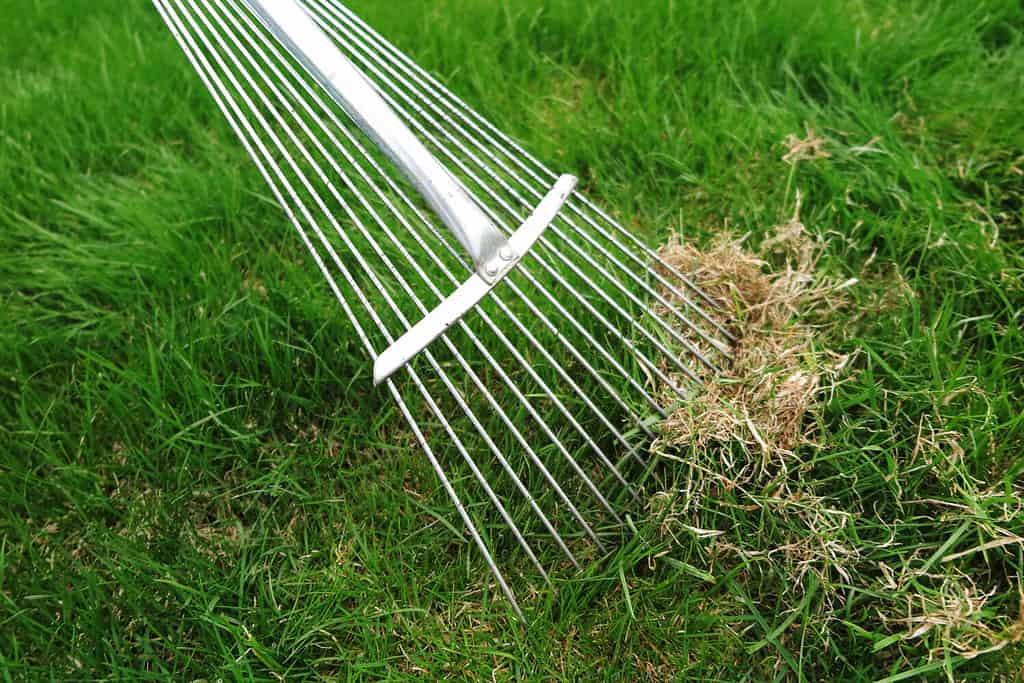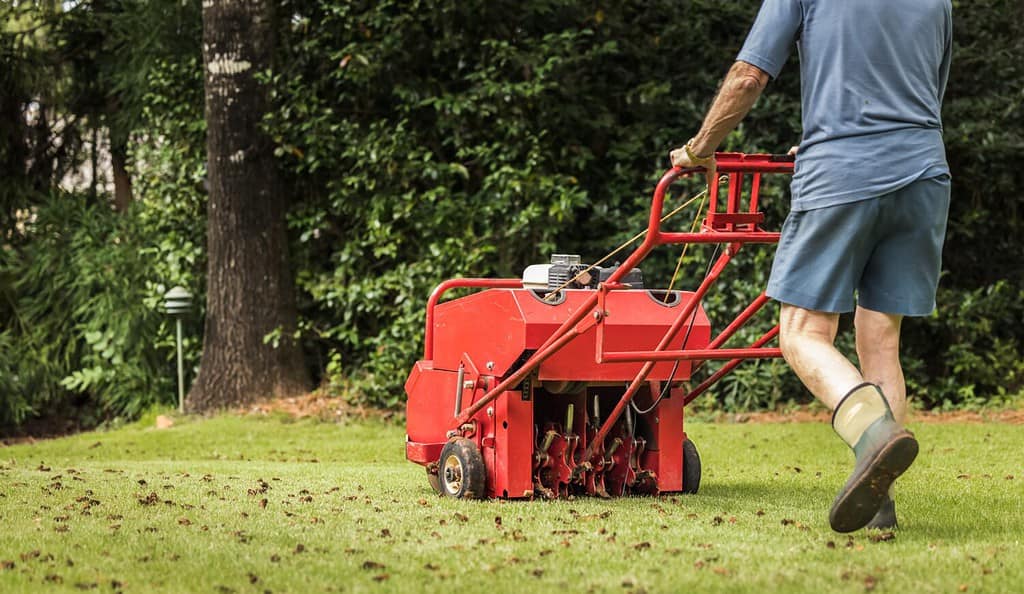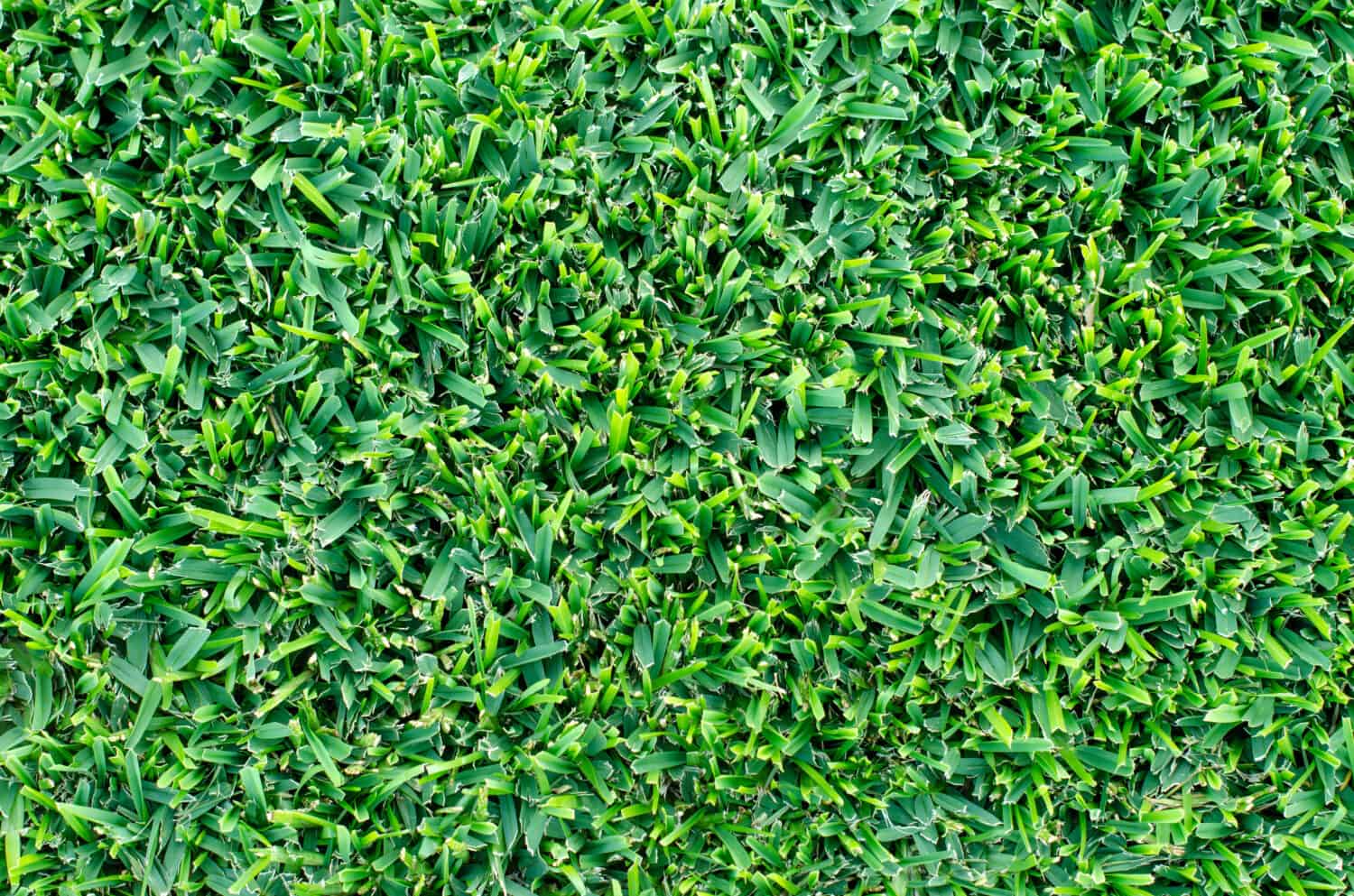A vibrant, healthy lawn is the pride of any homeowner, but achieving that lush green carpet is a challenge. Two essential lawn care practices, aeration, and dethatching, help maintain your grass’s vitality. Compare dethatching vs. aerating and explore the key differences between these two crucial processes. Understanding how and when to aerate or dethatch your lawn is the first step toward ensuring a thriving outdoor oasis. So, let’s dig deep into the world of lawn care to uncover the secrets behind a robust, verdant yard.
What Is Dethatching?
Dethatching, also known as thatch removal or scarification, is a fundamental lawn maintenance practice aimed at addressing a common problem in many lawns: thatch buildup. But what exactly is thatch? Thatch is the layer of dead grass, roots, and other organic matter that accumulates on the soil’s surface over time. While some thatch is normal and beneficial for a lawn, excessive thatch is problematic.
Thatch buildup occurs when organic debris decomposes slower than it accumulates. This layer creates a barrier, preventing water, air, and nutrients from reaching the soil and grass roots effectively. As a result, it leads to various issues, such as poor drainage, increased vulnerability to pests and diseases, and a lack of essential nutrients for your grass.
Dethatching Methods
Dethatching involves the removal of this excessive thatch layer to restore a healthier balance in your lawn. There are various methods for dethatching, including manual dethatching with a thatch rake or using specialized dethatching machines, also known as dethatchers or scarifiers. These machines use blades or tines to cut into the thatch layer and pull it up to the surface for removal.

Removing thatch is important for a healthy lawn.
©photowind/Shutterstock.com
What Is Aeration?
Aeration is another fundamental lawn care practice that involves perforating the soil with small holes to improve air, water, and nutrient penetration to the grassroots. This process is crucial for maintaining a healthy and vibrant lawn.
Over time, the soil becomes compacted due to factors such as heavy foot traffic, lawn machinery, or clay-rich soil. Compacted soil restricts the movement of essential elements, making it challenging for grassroots to access oxygen, water, and nutrients. As a result, your lawn may suffer from poor growth, weak roots, and increased vulnerability to stressors like drought and disease.
Aeration creates channels or holes in the soil, allowing air, water, and nutrients to reach your grassroots more efficiently.
Types of Aeration
There are two common types of aeration:
- Core aeration employs a specialized machine known as a core aerator or plug aerator. It removes small plugs or cores of soil and thatch from your lawn and deposits them on the surface. These cores break down, enhancing the soil structure and encouraging deeper roots.
- Spiking or tine aeration involves puncturing the soil with spikes or solid tines without removing cores. While not as effective as core aeration, it still improves soil aeration.

Aeration promotes bacteria and fungi activity and helps degrade thatch buildup.
©The Toidi/Shutterstock.com
5 Key Differences Between Dethatching and Aeration
Maintaining a vibrant, green lawn requires more than regular mowing and watering. Two critical lawn care practices, dethatching, and aeration, play distinct roles in nurturing healthy grass. Here are five key differences that set them apart:
Dethatching vs. Aerating Purpose
The purpose of lawn care practices like dethatching and aeration is to maintain and enhance your lawn’s health, vigor, and overall appearance.
Dethatching
Dethatching aims to address the issue of thatch buildup. Thatch is the layer of dead grass, roots, and organic matter that accumulates on the soil’s surface. When thatch becomes excessive, it hinders the health of your lawn by creating a barrier that restricts the movement of water, air, and nutrients to the roots. The purpose of dethatching is to:
- Remove thatch: Dethatching removes the excessive thatch layer, allowing for improved water absorption, better nutrient uptake, and enhanced air circulation within the soil.
- Prevent problems: By reducing thatch, dethatching helps prevent issues such as poor drainage, increased vulnerability to pests and diseases, and nutrient deficiencies in your grass.
- Enhance grass health: Dethatching rejuvenates your lawn’s appearance and promotes healthier, more robust grass growth.
Aeration
Aeration focuses on improving the structure and health of your soil by enhancing its ability to support healthy growth. The purpose of aeration is to:
- Alleviate soil compaction: Aeration helps break up compacted soil. Compacted soil limits the movement of essential elements and inhibits grassroots access to oxygen, water, and nutrients.
- Facilitate nutrient uptake: By creating openings in the soil, aeration enables better nutrient absorption and root development, leading to healthier, more resilient grass.
- Enhance drought resistance: Improved soil aeration increases water infiltration and retention, making the lawn more resistant to drought conditions.
- Reduce thatch accumulation: Aeration can also help reduce thatch accumulation by promoting the decomposition of organic matter.
In summary, the purpose of dethatching is to remove excessive thatch and maintain a well-balanced lawn, while aeration aims to enhance soil health and support the growth of robust, lush grass. Both practices are vital components of effective lawn care, working together to ensure your lawn thrives year-round.
Dethatching vs. Aerating Method
Both dethatching and aeration are essential lawn care practices, each with distinct methods tailored to their specific purposes:
Dethatching
- Assessment: Begin by assessing the lawn to determine if dethatching is necessary. Check for signs of excessive thatch buildup, such as a spongy feel underfoot, poor water penetration, or a dull, unhealthy appearance.
- Equipment: You can opt for manual dethatching using a thatch rake or choose a power dethatcher. The power dethatcher is more efficient for larger lawns. However, it is more costly to buy or rent.
- Dethatching process: For manual dethatching, vigorously rake the lawn, pulling up the thatch and dead grass. Work systematically to cover the entire area. However, if using a power dethatcher, adjust the blade height to the appropriate depth and run the machine across your lawn. It will pull up and collect the thatch as it goes.
- Cleanup: After dethatching, collect and remove the pulled-up thatch and debris from your lawn.
- Recovery: Your lawn may appear somewhat distressed immediately after dethatching. Water the lawn to help it recover, and also consider overseeding to fill in any gaps.
Aeration
- Assessment: Assess the need for aeration by considering factors like soil compaction, thatch accumulation, and the overall health of your lawn.
- Equipment: Use a core aerator or spike aerator, both available for rent or purchase. Core aeration is generally more effective but also more expensive.
- Aeration process: If using a core aerator, adjust the depth to penetrate the soil adequately. The machine will remove small plugs or cores of soil and deposit them on your lawn’s surface. However, if using a spike aerator, simply walk or roll the machine over your lawn, creating holes in the soil without removing cores.
- Cleanup: Leave the soil cores on your lawn’s surface. They will break down over time and help improve soil structure.
- Recovery: Water your lawn to aid in soil settlement and recovery. Consider overseeding to promote healthy grass growth in the new openings.
The methods for dethatching and aeration involve specific tools and techniques tailored to their respective purposes. Proper execution of these methods is crucial for maintaining a thriving and resilient lawn.

Timing plays a crucial role in dethatching and aeration to limit the spread of disease.
©Zaid Harith/Shutterstock.com
Dethatching vs. Aerating Timing
Timing plays a crucial role in the success of both dethatching and aeration, as it ensures that these lawn care practices are most effective and least disruptive to your grass. Here’s a closer look at the optimal timing for each:
Dethatching
- Season: Perform dethatching in the early spring or late fall. These seasons are ideal because your grass is not in its peak growth phase, reducing the stress on your lawn.
- Soil moisture: Choose a day when the soil is slightly moist but not excessively wet. Dethatching on overly wet soil is challenging and may harm your lawn.
- Cool-season vs. warm-season grasses: Consider your grass type. For cool-season grasses like Kentucky bluegrass and fescue varieties, the early spring or late fall is ideal. However, warm-season grasses such as Bermuda or zoysia benefit from dethatching in the late spring to early summer.
Aeration
- Season: Perform aeration during the growing season when your grass can recover more effectively.
- Soil moisture: Ensure the soil is moderately moist but not overly saturated. Aeration on dry soil is less effective, while excessively wet soil leads to soil compaction.
- Cool-season vs. warm-season grasses: For cool-season grasses like tall fescue or perennial ryegrass, the early spring or early fall is preferred. However, warm-season grasses benefit from aeration in the late spring to early summer.
- Overseeding: If you plan to overseed your lawn, it is best to do so immediately after aeration. The newly created openings in the soil provide an excellent environment for seed germination and root development.
The timing of dethatching and aeration is crucial for their success. Proper timing ensures that your lawn can recover quickly and benefit most from these essential lawn care practices.
Dethatching vs. Aerating Frequency
Determining how often to perform dethatching and aeration is essential. The frequency of these lawn care practices depends on various factors, including your lawn’s specific needs and conditions. Here’s a closer look at the recommended frequency for both dethatching and aeration:
Dethatching
Generally, for lawns with moderate thatch accumulation, dethatching annually is a reasonable guideline. However, it’s essential to monitor your lawn’s condition and adjust your frequency accordingly. Some lawns may need biannual dethatching, while others may go longer between sessions.
- Thatch buildup: The primary factor influencing the frequency of dethatching is the extent of thatch buildup in your lawn. Thatch should be managed before it becomes excessive and starts causing problems.
- Grass type: Your grass type also influences dethatching frequency. For instance, cool-season grasses like Kentucky bluegrass and fescue require less frequent dethatching than warm-season grasses like Bermuda or zoysia.
- Lawn use: Lawns subjected to heavy foot traffic or other forms of stress accumulate thatch more rapidly. In such cases, more frequent dethatching is necessary.
- Climate and soil type: Regions with heavy rainfall or specific soil types may experience faster thatch accumulation. Pay attention to local conditions when determining your frequency.
- Dethatching equipment: The type of dethatching equipment you use also impacts your frequency. Power dethatchers are more efficient and may allow for longer intervals between dethatching sessions compared to manual dethatching with a thatch rake.
Aeration
- Soil type: The frequency of aeration depends on your soil type. Lawns with heavy clay soil or high compaction levels benefit from more frequent aeration, typically every one to two years.
- Lawn use: Lawns that endure heavy traffic, such as play areas or sports fields, may require more frequent aeration to counteract soil compaction.
- Grass type: The type of grass you have also plays a role. Cool-season grasses benefit from aeration every one to two years, while warm-season grasses may need it less often.
- Soil condition: Regularly check your soil’s condition. If you notice signs of compaction or poor water infiltration, it may be time for aeration.
- Overseeding: If overseeding is part of your lawn care routine, consider aerating before overseeding to create an optimal environment for new grass seed to establish.
Ultimately, the frequency of dethatching and aeration varies depending on factors like thatch accumulation, grass type, soil condition, and lawn use. Regular monitoring and adjustment of your lawn care schedule will ensure that you address your lawn’s specific needs effectively.

Dethatching and aeration work together to create a lush, green carpet.
©SingjaiStocker/Shutterstock.com
Dethatching vs. Aerating Benefits
Both dethatching and aerating are vital lawn care practices that offer a range of benefits to your lawn’s health and overall appearance. Understanding these advantages can help you appreciate the importance of incorporating both into your lawn care routine:
Dethatching
- Thatch removal: The primary benefit of dethatching is to remove excessive thatch. This reduces the risk of thatch becoming a barrier that inhibits water, air, and nutrient penetration into the soil.
- Improved water absorption: Dethatching enhances water penetration into the soil, reducing the risk of surface runoff and water waste. This is especially beneficial during periods of drought.
- Enhanced nutrient uptake: With reduced thatch, nutrients can reach roots more effectively, promoting healthier and more vigorous growth.
- Reduced pest and disease risk: Thatch removal decreases the hiding spots for pests and reduces the risk of fungal diseases, such as snow mold, that thrive in moist thatch layers.
- Enhanced lawn appearance: Dethatching rejuvenates your lawn’s appearance, leading to a thicker, greener, and more vibrant grass carpet.
Aeration
- Alleviates soil compaction: Aeration effectively combats soil compaction, allowing roots to access oxygen, water, and nutrients more easily. This also promotes robust root growth.
- Enhanced water infiltration: Aeration creates openings in the soil that improve water infiltration and reduce runoff, making your lawn more resilient during periods of heavy rainfall or drought.
- Nutrient absorption: Improved soil aeration facilitates better nutrient uptake by roots, leading to healthier and more nutrient-rich grass.
- Drought resistance: Aeration helps your lawn cope with dry conditions by enhancing its ability to retain moisture and reducing the risk of drying out.
- Thatch decomposition: Over time, the soil cores left on your lawn’s surface after aeration break down, contributing to thatch decomposition and healthier soil.
- Overseeding effectiveness: Aeration creates ideal conditions for overseeding by providing seed with direct access to soil, increasing germination rates, and establishing of new grass.
Dethatching addresses thatch buildup and its associated problems, while aeration focuses on soil health and grassroots access to essential elements. When combined, these practices ensure a lush, healthy, and resilient lawn that’s the envy of the neighborhood.
Bringing It All Together: The Importance of Dethatching vs. Aerating
Maintaining a beautiful and thriving lawn is a labor of love, requiring dedicated care and attention. Two key players, dethatching and aeration, serve unique but equally essential roles in ensuring your lawn’s health and vitality.
Dethatching addresses the surface-level impediments to your lawn’s growth to promote improved water absorption, enhanced nutrient uptake, and a reduced risk of pest infestations and diseases. On the other hand, aeration delves deep into the soil’s core, combating compaction and creating pathways for essential elements like oxygen, water, and nutrients to reach roots.
The secret to a truly vibrant lawn lies in recognizing that dethatching and aeration are not competing practices; rather, they complement each other. Together, they form a powerful duo, tackling issues at both the surface and sub-surface levels.
Thank you for reading! Have some feedback for us? Contact the AZ Animals editorial team.








